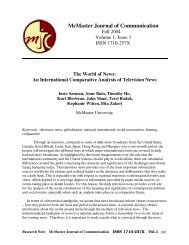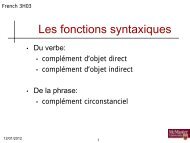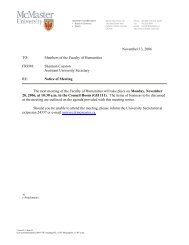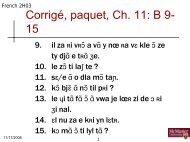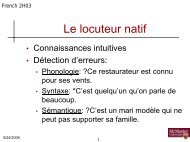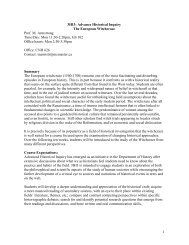The Syntax of Givenness Ivona Kucerová
The Syntax of Givenness Ivona Kucerová
The Syntax of Givenness Ivona Kucerová
Create successful ePaper yourself
Turn your PDF publications into a flip-book with our unique Google optimized e-Paper software.
(23) What can be understood as new?<br />
a. (i) What did Marie give to Pavel?<br />
(ii) Marie dala Pavlovi [facku] New ←− slap<br />
b. (i) What did Marie give to whom?<br />
(ii) Marie dala [Pavlovi facku] New ←− Pavel a slap<br />
c. (i) What did Marie do?<br />
(ii) Marie [dala Pavlovi facku] New ←− gave Pavel a slap<br />
d. (i) What happened?<br />
(ii) [Marie dala Pavlovi facku] New ←− Marie gave Pavel a slap<br />
In contrast, if an utterance contains any deviance from the basic order, then such an utterance<br />
is infelicitous in an all-new context. It means that if any reordering takes place,<br />
at least one constituent must be α G , i.e., introduced in the previous discourse. In other<br />
words, any reordering limits the number <strong>of</strong> structural positions in which we can identify<br />
the partition between given and new. For example, in a derived word order, as in (24), there<br />
is only one felicitous interpretation <strong>of</strong> the information structure. More precisely, only the<br />
rightmost constituent can be interpreted as new (non-G). In this particular case, it is the<br />
indirect object Pavel. Thus, in (24) there is only one possible partition between given and<br />
new, in contrast to (22) that is compatible with several partitions, as schematized in (25).<br />
(24) Focus Projection within a derived word order:<br />
a. Marie dala facku [Pavlovi] New ←− S V DO || IO t DO<br />
b. #Marie dala [facku Pavlovi] New<br />
c. #Marie [dala facku Pavlovi] New<br />
d. #[Marie dala facku Pavlovi] New<br />
(25) a. Marie dala facku || Pavlovi.<br />
b. (||) Marie (||) dala (||) Pavlovi (||) facku.<br />
What we can learn from the observed pattern is that in basic word order there is a relative<br />
freedom in what parts <strong>of</strong> the utterance can be interpreted as new and what parts can be interpreted<br />
as given. As I have already anticipated in the previous discussion <strong>of</strong> G-movement,<br />
this pattern can be described in the following manner: whatever is interpreted as given cannot<br />
be linearly preceded by anything interpreted as new.<br />
Let’s now turn to the question <strong>of</strong> how exactly the multiple partition effect follows from<br />
our system. To see that, we will look at a very simple case: a transitive clause that has no<br />
modifiers, only a subject, a verb, and an object. Consider first the case where the subject is<br />
the only given element. As we already know, the resulting word order is SVO, as seen in<br />
(26) and (27). 16<br />
(26) a. Subject-G verb Object ←−<br />
b. #Object verb Subject-G<br />
16 I use here examples with potom ‘then, afterward’ instead <strong>of</strong> a wh-question. <strong>The</strong> reason is that potom<br />
creates a natural context where only the subject is presupposed/given. For reasons that are not clear to me, it<br />
is difficult to obtain the same pragmatic effect with a wh-question.<br />
19







